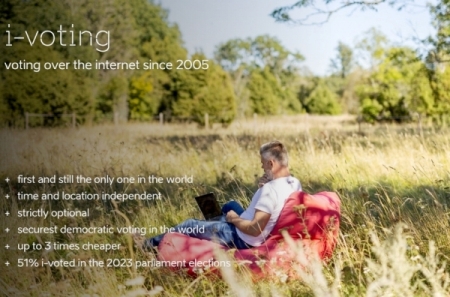Out of the many things the “Pandemic of the Century”- Covid– changed was digitalization interface on a scale that the world had not seen before. The entire world witnessed a phenomenon where human interaction became dangerous and digital interface was accepted as a safer, transparent, and in some cases, cost effective tool of communication as well.
Long before the world realised the great potential of digital interaction, a tiny country in eastern Europe had unknowingly been preparing for this situation for over two decades. It had moved most of its government work online with 99% of services available digitally.
Situated between Latvia and Russia with a long shoreline running along the Baltic Sea and Gulf of Finland, Estonia is well recognized as a champion of digital services, having successfully innovated the digital infrastructure and put it to ample use in all walks of life.
 This country of 1.3 million people has become a front runner among member states of the European Union in providing key public services for people and businesses, striving to make digital services available for every major life event. The country performs above the EU average in improving the public’s digital skills and ICT specialists already make up a high percentage of the employment (6.7%). Estonia also has the second highest percentage of female ICT specialists in the EU (26.8%). Close to 98% of the Estonian population has at least one e-ID.
This country of 1.3 million people has become a front runner among member states of the European Union in providing key public services for people and businesses, striving to make digital services available for every major life event. The country performs above the EU average in improving the public’s digital skills and ICT specialists already make up a high percentage of the employment (6.7%). Estonia also has the second highest percentage of female ICT specialists in the EU (26.8%). Close to 98% of the Estonian population has at least one e-ID.
In 2023, the Estonian government introduced new online applications to streamline administrative processes such as marriage, childbirth, military service, migration and death of a loved one. Today, be it education, energy, internal security, defense, business or trade, Estonian people are managing most of it in the digital space transparently and flawlessly.
However, the success of Estonian e-governance did not come easy. It was years of painstaking work with limited resources and a lot of resilience.One of the most important innovations that brought the digital society into political discourse in Estonia was the Tiger Leap programme which was launched in 1997. It aimed to buildschool infrastructure by providing them with access to the internet and computers.
The first step was to provide all schools with computers and internet access. All schools were provided with computers by 2000. By the year 2001, all schools were connected to the Internet. The local governments, whose priority was to expand school computer systems, received financial support from the Tiger Leap Foundation. The contribution was equal to what the schools were able to invest themselves.
 Basic ICT courses for teachers were organized. In 1997, nearly 4000 teachers participated in the 40-hour computer basic training course, with thousands more in the next few years. In 1999, new courses in electronic courseware, online information searches and preparation of educational materials were introduced. This investment in digital knowledge and infrastructure paid well for the Estonian people and government in the years to come.
Basic ICT courses for teachers were organized. In 1997, nearly 4000 teachers participated in the 40-hour computer basic training course, with thousands more in the next few years. In 1999, new courses in electronic courseware, online information searches and preparation of educational materials were introduced. This investment in digital knowledge and infrastructure paid well for the Estonian people and government in the years to come.
The e-state idea really took off after the “Stockholm initiative” that called for countries to develop their digital capacity, and Estonia was seen as the country with the most potential.
Today, it takes about 3 minutes to declare one’s taxes online, with 98% people registering their income electronically. About 95% of parking fees is paid via mobile phone. As many as 98% of Estonians have an ID card, with the overall digital signatures also save 2% of GDP annually. X-Road has become the backbone of e-Estonia, allowing the nation’s public and private sector information systems to link up and operate in harmony. A whopping 99% of public services are accessible online 24/7.
However, the country also had its share of troubleswhile going down the digital path. In April 2007, Estonia was hit by a massive cyber-attack, which was the most lethal organized cybercrimeagainst any country to date. International cooperation was needed to contain the emerging threat. For days, key services like health, education,transport and communication were affected, derailing the day-to-day life of all Estonians. But the nation used the bitter experience as a learning and have now become one of the leading countries in cyber security.
Both the NATO Cooperative Cyber Defence Centre of Excellence and the EU IT Agency are situated here in the capital Tallinn. To further strengthen e-governance, Estonia created a centre of excellence for data governance and open data. This centre improves the quality of the data collected and held by the Estonian public authorities, increasing its usability for decision-making and its availability as open data to other stakeholders
Digitalization is a priority in Estonia and the country has set greater targets for itself by adopting the National Digital Agenda for 2030, which was adopted in 2021. The Digital Strategy focuses on three areas: digital state, cybersecurityand connectivity. The focus is currently on linking services to life events and developing features that automatically suggest further steps. Another priority is providing the user interface and allowing for a seamless interaction with public services, irrespective of when and where, or from which device, the services are being accessed.
 Since the entire population and its government operates in digital space. There are umpteen vulnerabilities that may occur with either technical breach of data privacy or by human intervention. While the technical breach or hacking is taken care of by the best of the engineering minds to keep the corruptible human interventions at bay, there are strict guidelines as to who all can access the personnel data and in what conditions. A harsh punishment awaits those who are found to be violating these guidelines. Every access to any data has to be put on record with an explanation of its need. The Baltic nation which takes pride in its citizensmostly being law abiding, has seen very few violations, which too invited exemplary punishment irrespective of the social, economic or political standing of the culprits.
Since the entire population and its government operates in digital space. There are umpteen vulnerabilities that may occur with either technical breach of data privacy or by human intervention. While the technical breach or hacking is taken care of by the best of the engineering minds to keep the corruptible human interventions at bay, there are strict guidelines as to who all can access the personnel data and in what conditions. A harsh punishment awaits those who are found to be violating these guidelines. Every access to any data has to be put on record with an explanation of its need. The Baltic nation which takes pride in its citizensmostly being law abiding, has seen very few violations, which too invited exemplary punishment irrespective of the social, economic or political standing of the culprits.
That is probably another reason why this country is today seen as a model for the world in adopting best practices of e-governance.



 This country of 1.3 million people has become a front runner among member states of the European Union in providing key public services for people and businesses, striving to make digital services available for every major life event. The country performs above the EU average in improving the public’s digital skills and ICT specialists already make up a high percentage of the employment (6.7%). Estonia also has the second highest percentage of female ICT specialists in the EU (26.8%). Close to 98% of the Estonian population has at least one e-ID.
This country of 1.3 million people has become a front runner among member states of the European Union in providing key public services for people and businesses, striving to make digital services available for every major life event. The country performs above the EU average in improving the public’s digital skills and ICT specialists already make up a high percentage of the employment (6.7%). Estonia also has the second highest percentage of female ICT specialists in the EU (26.8%). Close to 98% of the Estonian population has at least one e-ID. Basic ICT courses for teachers were organized. In 1997, nearly 4000 teachers participated in the 40-hour computer basic training course, with thousands more in the next few years. In 1999, new courses in electronic courseware, online information searches and preparation of educational materials were introduced. This investment in digital knowledge and infrastructure paid well for the Estonian people and government in the years to come.
Basic ICT courses for teachers were organized. In 1997, nearly 4000 teachers participated in the 40-hour computer basic training course, with thousands more in the next few years. In 1999, new courses in electronic courseware, online information searches and preparation of educational materials were introduced. This investment in digital knowledge and infrastructure paid well for the Estonian people and government in the years to come. Since the entire population and its government operates in digital space. There are umpteen vulnerabilities that may occur with either technical breach of data privacy or by human intervention. While the technical breach or hacking is taken care of by the best of the engineering minds to keep the corruptible human interventions at bay, there are strict guidelines as to who all can access the personnel data and in what conditions. A harsh punishment awaits those who are found to be violating these guidelines. Every access to any data has to be put on record with an explanation of its need. The Baltic nation which takes pride in its citizensmostly being law abiding, has seen very few violations, which too invited exemplary punishment irrespective of the social, economic or political standing of the culprits.
Since the entire population and its government operates in digital space. There are umpteen vulnerabilities that may occur with either technical breach of data privacy or by human intervention. While the technical breach or hacking is taken care of by the best of the engineering minds to keep the corruptible human interventions at bay, there are strict guidelines as to who all can access the personnel data and in what conditions. A harsh punishment awaits those who are found to be violating these guidelines. Every access to any data has to be put on record with an explanation of its need. The Baltic nation which takes pride in its citizensmostly being law abiding, has seen very few violations, which too invited exemplary punishment irrespective of the social, economic or political standing of the culprits.









.jpg)




